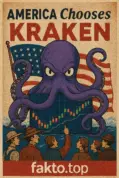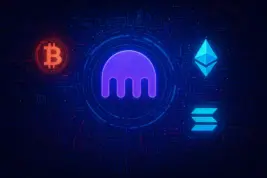Kraken in the USA (2025): Yields, Staking & Security That Still Hold Up
By 2025, the U.S. crypto scene isn’t about chasing moonshots anymore — it’s about staying afloat. After SEC crackdowns, staking bans, and a few exchanges going down in flames (if you lost funds, I feel you), nobody’s dreaming about Lambos. People just want a place to park their crypto, earn a bit, maybe stake — without waking up to frozen accounts or a half-baked “we regret to inform you” tweet.

It’s not hype season. It’s survival mode
Kraken? Far from perfect. The interface looks like it skipped a few upgrades, and yeah, it can be sluggish. But here’s the thing — it’s still here. Still regulated. Still paying. In this market, that kind of consistency feels almost heroic. After watching other platforms vanish overnight, get slapped with lawsuits, or quietly disappear on U.S. users, Kraken’s steady, no-drama approach starts to feel like a relief.
This guide walks through what Kraken actually offers Americans right now — savings, staking, custody, compliance. No hype, no rocket emojis, no promises of the “next Solana.” Just tools that still work when everything else looks like a rug waiting to happen.
Crypto Savings on Kraken: Steady Yields, No DeFi Drama
Kraken’s savings products are built for people who want passive income — without diving into sketchy DeFi pools. In 2025, they offer flexible and fixed savings on majr assets like USDC, BTC, ETH, and DOT. Rates aren’t moon-level, but they’re stable. And yeah — they’re legal.
| Asset | Flexible APY | Fixed APY | Lock Period |
|---|---|---|---|
| USDC | 3.5–5.5% | Up to 6.2% | 30 days |
| BTC | 1.2–2.5% | Up to 3.8% | 60 days |
| ETH | 2.0–4.5% | Up to 6.0% | 14 days |
| DOT | 4.0–7.5% | Up to 10.0% | 28 days |
USDC is the standout here. That 5.5% APY isn’t clickbait — it’s real, and it’s been holding steady. Flexible savings let you pull out anytime, while fixed plans reward you for locking in. No DeFi drama, no rug pulls — just clean, regulated yield.
Staking on Kraken: Back from the Dead
After Kraken’s 2023 SEC drama, most thought staking in the U.S. was toast. But in 2025, Kraken brought it back — legally, transparently, and with clear terms. And yeah, it’s surprisingly solid.

You’ve got on-chain staking for ETH, SOL, DOT, ADA — and even BTC via Babylon protocol. Yes, BTC staking is a thing now. And long-term holders are paying attention.
| Asset | Staking Type | Estimated APR | Unbonding Period |
|---|---|---|---|
| ETH | On-chain | 4.5–6.5% | 7 days |
| SOL | On-chain | 6.0–8.0% | 3 days |
| DOT | On-chain | 8.0–12.0% | 28 days |
| BTC (Babylon) | Layer-2 staking | 1.5–2.5% | Instant |
Kraken’s flexible staking is perfect if you don’t want your assets locked up for months. They also offer historical APR data, calculators, and alerts — so you can actually plan your yield strategy. Just double-check your state: places like New York and Hawaii still have restrictions. Annoying, but Kraken lists them clearly.
Security & Custody: Why Kraken Still Feels Safe
Kraken’s security setup? Honestly, it’s solid. Like, really solid. Around 95% of assets sit in cold storage — not just some marketing line, they actually do it. You’ve got 2FA, withdrawal whitelists, fund segregation — the usual stuff, but done right.
And here’s the twist: Kraken isn’t just another exchange. It’s got a SPDI bank charter in Wyoming. Yeah, a crypto bank. Not a wannabe, not a “we’re working on it” — an actual charter. That’s rare.
If you treat your crypto like long term capital — not just something to flip on Thursdays — this matters. Real oversight. Real rules. Real accountability./
Still, let’s be real: no platform is bulletproof. Even with all the regulation, you should still use hardware wallets for big bags, turn on every security toggle you can find, and don’t keep everything in one place. Kraken’s handled traffic spikes and market chaos pretty well, but smart custody? That’s still on you.

Regulation: Kraken’s Survival Playbook
Kraken didn’t dodge U.S. regulators — it walked straight into the fire. Registered with FinCEN, worked with the CFTC, rebuilt staking to fit SEC rules. That’s why it’s still here while others bailed or got slapped.
Could the SEC change the rules again? Sure. They’ve done it before. But right now, Kraken’s compliance gives it a kind of legitimacy most platforms just don’t have. It’s one of the few places where Americans can stake, earn, and store crypto without sweating every headline.
Should You Use Kraken in 2025?
Depends what you’re after. If you’re chasing 20% APY on some random token you found in a Telegram thread — Kraken’s not it. But if you want stable returns, legal staking, and actual security — especially in the U.S. — it’s one of the last good options.
The UI? Yeah, it feels a bit 2018. Some features are buried. And those state-by-state staking rules? Annoying. Really annoying. But the core stuff — savings, staking, security — it’s solid. And in 2025, that’s rare.

Final Thoughts
Kraken’s not trying to be flashy. It’s trying to survive. And help users do the same. In a market full of noise, rug pulls, and regulatory curveballs, that’s worth something.
Whether you’re cautious, long-term, or just trying to earn a bit of yield without getting flagged — Kraken still makes sense. It’s not perfect. But it’s here. It works. And it’s legal.
Before you jump in, check your state’s eligibility (seriously), skim the staking terms, and keep your expectations grounded. Crypto in 2025 isn’t about moonshots — it’s about staying in the game. And Kraken? Still in the game.
What Is Kraken and Its Status in the USA?
Kraken’s been around longer than most — and in 2025, its U.S. status matters more than ever. While offshore platforms ducked regulations or bailed entirely, Kraken leaned in. It’s registered with FinCEN, plays nice with the CFTC, and rebuilt its staking model to satisfy the SEC.
It even locked down a banking charter in Wyoming — making it one of the few crypto platforms with real regulatory muscle.
Kraken doesn’t chase hype. It doesn’t offer the highest APYs or the flashiest altcoins. What it does offer is rare: legal access to savings, staking, and secure storage — all under U.S. law. That alone makes it a standout.
Savings & Rewards (USDC, Bitcoin via Babylon)
Kraken’s savings products are built for users who want passive income without regulatory headaches. USDC is the star here, with flexible rates up to 5.5% APY — competitive even against some DeFi platforms, but with way less risk.
That offer — often searched as “Kraken USDC 5.5% APY Kraken USA” — consistently ranks among the top earn-related queries in the U.S. market.
More interestingly, Kraken now supports Bitcoin staking via Babylon — a Layer-2 protocol that lets BTC holders earn yield without giving up custody. No wrapped tokens, no sketchy bridges. Just native BTC earning 1.5–2.5% APY. It’s early-stage, but gaining traction fast.
Staking: Eligible Assets, Rates, Flexible vs Bonded
Staking on Kraken is back — and better structured than before. After the SEC showdown, Kraken shifted to on-chain staking with clear terms and state-by-state eligibility.
Top assets include ETH, SOL, DOT, ADA, and ATOM, with APRs ranging from 4% to 12% depending on network conditions.
You can go flexible (instant withdrawal, lower yield or bonded (locked for 7–30 days, higher yield). Flexible staking suits short-term holders and traders. Bonded staking is for the long game.
Just don’t skip the fine print — some states still block access. Kraken staking restrictions in places like New York, Texas, and Hawaii are real. Annoying, but clearly listed.
Legal/Regulatory Backdrop: SPDI Charter, SEC Settlement, State Availability
Kraken’s legal setup is one of its biggest strengths. It holds a Special Purpose Depository Institution (SPDI) charter in Wyoming — basically a crypto-native banking license. That’s a big deal for institutions and compliance-focused users.
The 2023 SEC settlement forced Kraken to pause staking-as-a-service. But in 2025, it’s back — rebuilt to meet SEC and state-level rules. Not every state is eligible, but Kraken makes it easy to check your status and stay compliant.
Custody, Security, Storage Features for U.S. Users
Security is where Kraken really delivers. 95% of assets sit in cold storage. You get multi-layer authentication, withdrawal whitelists, and strict fund segregation.
Unlike most exchanges, Kraken actually publishes its custody architecture and insurance coverage — giving peace of mind to both retail and institutional users.
For long-term holders, Kraken works like a hybrid: hot wallet liquidity with cold wallet protection. It’s not a hardware wallet replacement, but it’s close. And with its SPDI charter, Kraken is legally bound to stay solvent and transparent — a rare promise in crypto.
How Kraken Stands vs Competitors for U.S. Customers
| Exchange | Regulatory Status | Staking Available | Savings Products | Custody Transparency |
|---|---|---|---|---|
| Kraken | Fully regulated (FinCEN, CFTC, SPDI) | Yes (on-chain, state-dependent) | Yes (USDC, BTC, ETH) | High (cold storage, insurance) |
| Coinbase | SEC-registered, publicly traded | Limited (ETH only in some states) | Minimal (no flexible savings) | Moderate |
| Binance.US | Restricted in multiple states | Limited (SOL, ADA) | Yes, but inconsistent | Low |
| Bybit | Not licensed in the U.S. | No (VPN workaround only) | High APY, but not legal | Unknown |
Kraken’s not here to impress you with flashy banners or influencer hype. It’s not trying to be cool. It’s trying to survive — and help you do the same. In 2025, that’s a flex. Because let’s be honest: most platforms either bailed, got sued, or turned into some offshore casino with 200x leverage and zero support.
Kraken’s boring. And that’s exactly why it works.
For U.S. users who actually care — about legality, custody, and not waking up to a frozen account — Kraken is one of the last platforms that still makes sense. It’s not chasing trends. It’s not promising 20% APY on some token you’ve never heard of. It’s just… functioning. Legally.
Coinbase? Sure, it’s got the brand. Feels like the Apple Store of crypto. Bybit? Flashy APYs, slick UI, and a vibe that screams “degen playground.” But Kraken? Kraken’s the quiet one in the corner, stacking compliance docs and cold wallets like it’s prepping for crypto winter — again.
And you know what? That’s kind of comforting.
Real staking. Real savings. Real security. All wrapped in U.S. law, with a Wyoming bank charter and a side of “we’re still here.” Not sexy — but safe. And in this market, safe is underrated.
